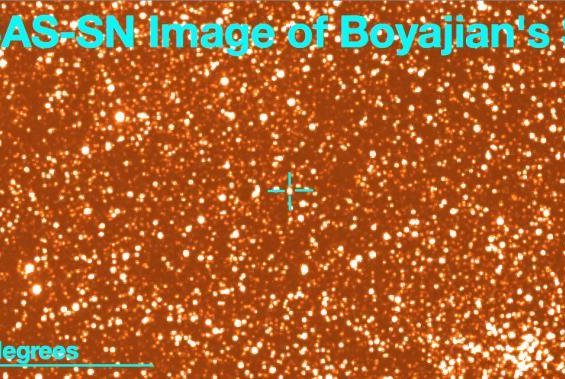The Milky Way's "most mysterious star" -- also known as Tabby's Star, Boyajian's Star an KIC 8462852 -- is pictured in the middle, at the crosshair. Photo by All-Sky Automated Survey for Supernovae/Carnegie Science
Oct. 4 (UPI) -- Tabby's Star continues to confound astronomers. New analysis shows the Milky Way's 'most mysterious star' has experienced brief periods of brightening amid its prolonged dimming.
The star, officially titled KIC 8462852, and sometimes called Boyajian's Star, first caught astronomers attention in 2015. While monitoring the F-type main-sequence star, NASA's Kepler Space Telescope captured a series of rapid dimming events.
When researchers analyzed archival observation of the star, they found Tabby's Star has been gradually dimming for some time. Astronomers came up with a variety of explanations for the dimming episodes, including periodic transits by exoplanets or dust clouds.
However, a more recent survey of 11 years of KIC 8462852 observations revealed two brief brightening stints, further complicating the stellar mystery.
When Josh Simon and Benjamin Shappee, a pair of astronomers with Carnegie Science, looked at data from a pair detailed sky surveys, they found Tabby's Star experienced two brightening events between 2013 and 2015.
"Up until this work, we had thought that the star's changes in brightness were only occurring in one direction -- dimming," Simon explained. "The realization that the star sometimes gets brighter in addition to periods of dimming is incompatible with most hypotheses to explain its weird behavior."
Simon and his colleagues shared their findings online this week.
"An important next step will be to determine how the color of the star changes with time, especially during its brief dips in brightness," said Shappee. "That information would help narrow down the possible explanations for why this star is doing such strange things."
To solve the mystery of Tabby's star's dimming and brightening, astronomers are now turning their attention to other measurable changes, like color shifts. A gas cloud transit would alter the color of the star's light, while a solid object, like a planet, wouldn't inspire a spectral shift.
"We haven't solved the mystery yet," Simon said. "But understanding the star's long-term changes is a key piece of the puzzle."















